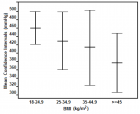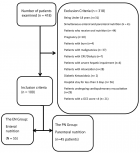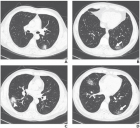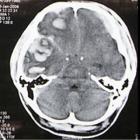Abstract
Research Article
Quantification of the pressures generated during insertion of an epidural needle in labouring women of varying body mass indices
Wee MYK*, Isaacs RA, Vaughan N, Dubey VN and Parker B
Published: 01 December, 2017 | Volume 1 - Issue 1 | Pages: 024-027
Objective: The primary aim of this study was to measure pressure generated on a Tuohy needle during the epidural procedure in labouring women of varying body mass indices (BMI) with a view of utilising the data for the future development of a high fidelity epidural simulator. High-fidelity epidural simulators have a role in improving training and safety but current simulators lack a realistic experience and can be improved.
Methods: This study was approved by the National Research Ethics Service Committee South Central, Portsmouth (REC reference 11/SC/0196). After informed consent epidural needle insertion pressure was measured using a Portex 16-gauge Tuohy needle, loss-of-resistance syringe, a three-way tap, pressure transducer and a custom-designed wireless transmitter. This was performed in four groups of labouring women, stratified according to BMI kg/m2: 18-24.9; 25-34.9; 35-44.9 and >=45. One-way ANOVA was used to compare difference in needle insertion pressure between the BMI groups. A paired t-test was performed between BMI group 18-24.9 and the three other BMI groups. Ultrasound images of the lumbar spine were undertaken prior to the epidural procedure and lumbar magnetic resonance imaging (MRI) was performed within 72h post-delivery. These images will be used in the development of a high fidelity epidural simulator.
Results: The mean epidural needle insertion pressure of labouring women with BMI 18-24.9 was 461mmHg; BMI 25-34.9 was 430mmHg; BMI 35-44.9 was 415mmHg and BMI >=45 was 376mmHg, (p=0.52).
Conclusion: Although statistically insignificant, the study did show a decreasing trend of epidural insertion pressure with increasing body mass indices.
Read Full Article HTML DOI: 10.29328/journal.hacr.1001004 Cite this Article Read Full Article PDF
Keywords:
Epidural; Pressures; Simulation; Obstetrics
References
- Royal College of Anaesthetists. Curriculum for a CCT in Anaesthetics, version 2. London. 2010. Ref.: https://goo.gl/RjbRCi
- Bruce RCH, McLeod ADM, Smith GB. A survey of UK anaesthetic trainee attitudes towards simulator based training experience. Bulletin of the Royal College of Anaesthetists. 2005; 34: 1722-1723. Ref.: https://goo.gl/RM27DZ
- Gaba DM. Improving Anesthesiologists’ Performance by Simulating Reality. Anesthesiology. 1992; 76: 491-494.
- Zausig YA, Bayer Y, Hacke N, Sinner B, Zink W et al. Simulation as an additional tool for investigating the performance of standard operating procedures in anaesthesia. Bri J Anaesth. 2007; 99: 673-678. Ref.: https://goo.gl/HNUWNT
- Kneebone RL, Nestel D, Vincent C, Darzi A. Complexity, risk and simulation in learning procedural skills. Medical Education. 2007; 41: 808-814. Ref.: https://goo.gl/GhxQXw
- Vaughan N, Dubey VN, Wee MYK, Isaacs RA. A review of epidural simulators: where are we today? Med Eng Phys. 2013; 35: 1235-50. Ref.: https://goo.gl/UMiJ1R
- Cook TM, Counsell D, Wildsmith JAW. Major complications of central neuraxial block: report on the Third National Audit of The Royal College of Anaesthetists. Bri J Anaesth. 2009; 102: 179-190. Ref.: https://goo.gl/XjAPnp
- Paech MJ, Godkin R, Webster S. Complications of obstetric analgesia and anaesthesia: a prospective analysis of 10,995 cases. Int J Obstet Anesth. 1998; 7: 5-11. Ref.: https://goo.gl/aJTwam
- Jenkins JG. Some immediate serious complications of obstetric analgesia and anaesthesia: a prospective study of 145,550 epidurals. Int J Obstet Anesth. 2005; 14: 37-42. Ref.: https://goo.gl/obXK7s
- Gleeson CM, Reynolds F. Accidental dural puncture rates in the UK. Int J Obstet Anesth. 1998; 7: 242-246. Ref.: https://goo.gl/JHMRNV
- Gupta S, Collis R, Harries S. Increasing dural tap rate: is this a national trend? International Journal of Obstetric Anesthesia. 2007; 16: 17.
- Grantcharov TP, Reznick RK. Teaching procedural skills. BMJ. 2008; 336: 1129-1131. Ref.: https://goo.gl/sDxP7E
- Smith TS, Johannsson HE, Sadler C. Trials of labour: can simulation make a difference to obstetric anaesthetic training? Current Anaesthesia and Critical Care. 2005; 16: 289-296. : https://goo.gl/57KpYd
- Aggarwal R, Darzi A. Technical skills training in the 21st century. New Eng J Med. 2006; 355: 2695-2696. Ref.: https://goo.gl/HWxFq1
- Bamgbade OA, Khalaf WM, Ajal O, Sharma R, Chidambaram V et al. Obstetric anaesthesia outcome in obese and non-obese parturients undergoing caesarean delivery: an observational study. Int J Obstet Anesth. 2009; 18: 221-225. Ref.: https://goo.gl/3U36u4
- Perlow JH, Morgan MA. Massive maternal obesity and perioperative caesarean morbidity. Am J Obstet Gynecol. 1994; 170: 560-565. Ref.: https://goo.gl/2KYVGP
- Hood DD, Dewan DM. Anesthetic and obstetric outcome in morbidly obese parturients. Anesthesiology. 1993; 79: 1210-1218. : https://goo.gl/EvgPTt
- Dresner M, Brocklesby J, Bamber J. Audit of the influence of body mass index on the performance of epidural analgesia in labour and the subsequent mode of delivery. BJOG. 2006; 113: 1178-1181. Ref.: https://goo.gl/dLZzGB
- Isaacs RA, Wee MYK, Dubey VN, Vaughan N. Current training in epidural analgesia: a survey of UK practice. Poster presented at Obstetric Anaesthesia 2013. Bournemouth. 2013; UK. Ref.: https://goo.gl/rGU5UT
- Vaughan N, Dubey VN, Wee MYK, Isaacs RA. Towards a realistic in vitro experience of epidural Tuohy needle insertion. Proceedings of the Institute of Mechanical Engineers. Part H: J Eng Med. 2013; 227: 767-777. Ref.: https://goo.gl/t43mL2
- Rodeira J, Calabuig R, Aliaga L, Espinosa W, Hobeich F et al. Mathematical analysis of epidural space location. Int J Clin Monitoring Computing. 1995; 12: 213-217. Ref.: https://goo.gl/paciJj
- Tran D, Hor KW, Kamani AA, Lessoway VA, Rohling RN. Instrumentation of the loss-of-resistance technique for epidural needle insertion. IEEE Transactions of Biomedical Engineering. 2009; 56: 820-827. Ref.: https://goo.gl/wUwCwE
Figures:

Figure 1

Figure 2

Figure 3
Similar Articles
-
Quantification of the pressures generated during insertion of an epidural needle in labouring women of varying body mass indicesWee MYK*,Isaacs RA,Vaughan N,Dubey VN,Parker B. Quantification of the pressures generated during insertion of an epidural needle in labouring women of varying body mass indices . . 2017 doi: 10.29328/journal.hacr.1001004; 1: 024-027
-
Assessing the Neurocognitive function effects of ketamine in Cardiac Surgical patientsDemet Dogan Erol*. Assessing the Neurocognitive function effects of ketamine in Cardiac Surgical patients . . 2018 doi: 10.29328/journal.ijcar.1001007; 2: 018-022
-
Effects of intraoperative epidural anesthesia during hepatectomy on intraoperative and post-operative patient outcomesChristopher Mallard,Brad Withers,Brooke Bauer,Paul A Sloan,Sean Dineen,Annette Rebel*. Effects of intraoperative epidural anesthesia during hepatectomy on intraoperative and post-operative patient outcomes. . 2018 doi: 10.29328/journal.ijcar.1001008; 2: 023-030
-
A witnessed intra-operative blood transfusion-related air embolism under epidural anaesthesia for vesicovaginal fistula repairGyadale AN*,Adeyanju BT,Ayegbusi EO,Adeyiolu AT,Olabode AA,Suberu SO,Olajide MA. A witnessed intra-operative blood transfusion-related air embolism under epidural anaesthesia for vesicovaginal fistula repair. . 2022 doi: 10.29328/journal.ijcar.1001018; 6: 001-003
Recently Viewed
-
Endometriosis as a risk factor for colorectal cancerVíctor Manuel Vargas-Hernández*,José María Tovar- Rodríguez,Víctor Manuel Vargas-Aguilar . Endometriosis as a risk factor for colorectal cancer. Clin J Obstet Gynecol. 2020: doi: 10.29328/journal.cjog.1001057; 3: 093-097
-
Adult Neurogenesis: A Review of Current Perspectives and Implications for Neuroscience ResearchAlex, Gideon S*,Olanrewaju Oluwaseun Oke,Joy Wilberforce Ekokojde,Tolulope Judah Gbayisomore,Martina C. Anene-Ogbe,Farounbi Glory,Joshua Ayodele Yusuf. Adult Neurogenesis: A Review of Current Perspectives and Implications for Neuroscience Research. J Neurosci Neurol Disord. 2024: doi: 10.29328/journal.jnnd.1001102; 8: 106-114
-
Analysis of Psychological and Physiological Responses to Snoezelen Multisensory StimulationLucia Ludvigh Cintulova,Jerzy Rottermund,Zuzana Budayova. Analysis of Psychological and Physiological Responses to Snoezelen Multisensory Stimulation. J Neurosci Neurol Disord. 2024: doi: 10.29328/journal.jnnd.1001103; 8: 115-125
-
Sexual Dimorphism in the Length of the Corpus Callosum in CadaverShahnaj Pervin*,Nasaruddin A,Irfan M,Annamalai L. Sexual Dimorphism in the Length of the Corpus Callosum in Cadaver. J Neurosci Neurol Disord. 2024: doi: 10.29328/journal.jnnd.1001104; 8: 126-129
-
Improvement of the Cognitive Abilities in a Chronic Generalized Anxiety Disorder and Moderate Depression Case using a Novel Integrated Approach: The Cognitome ProgramMohita Shrivastava*. Improvement of the Cognitive Abilities in a Chronic Generalized Anxiety Disorder and Moderate Depression Case using a Novel Integrated Approach: The Cognitome Program. J Neurosci Neurol Disord. 2024: doi: 10.29328/journal.jnnd.1001100; 8: 069-089
Most Viewed
-
Evaluation of Biostimulants Based on Recovered Protein Hydrolysates from Animal By-products as Plant Growth EnhancersH Pérez-Aguilar*, M Lacruz-Asaro, F Arán-Ais. Evaluation of Biostimulants Based on Recovered Protein Hydrolysates from Animal By-products as Plant Growth Enhancers. J Plant Sci Phytopathol. 2023 doi: 10.29328/journal.jpsp.1001104; 7: 042-047
-
Sinonasal Myxoma Extending into the Orbit in a 4-Year Old: A Case PresentationJulian A Purrinos*, Ramzi Younis. Sinonasal Myxoma Extending into the Orbit in a 4-Year Old: A Case Presentation. Arch Case Rep. 2024 doi: 10.29328/journal.acr.1001099; 8: 075-077
-
Feasibility study of magnetic sensing for detecting single-neuron action potentialsDenis Tonini,Kai Wu,Renata Saha,Jian-Ping Wang*. Feasibility study of magnetic sensing for detecting single-neuron action potentials. Ann Biomed Sci Eng. 2022 doi: 10.29328/journal.abse.1001018; 6: 019-029
-
Pediatric Dysgerminoma: Unveiling a Rare Ovarian TumorFaten Limaiem*, Khalil Saffar, Ahmed Halouani. Pediatric Dysgerminoma: Unveiling a Rare Ovarian Tumor. Arch Case Rep. 2024 doi: 10.29328/journal.acr.1001087; 8: 010-013
-
Physical activity can change the physiological and psychological circumstances during COVID-19 pandemic: A narrative reviewKhashayar Maroufi*. Physical activity can change the physiological and psychological circumstances during COVID-19 pandemic: A narrative review. J Sports Med Ther. 2021 doi: 10.29328/journal.jsmt.1001051; 6: 001-007

HSPI: We're glad you're here. Please click "create a new Query" if you are a new visitor to our website and need further information from us.
If you are already a member of our network and need to keep track of any developments regarding a question you have already submitted, click "take me to my Query."
















































































































































